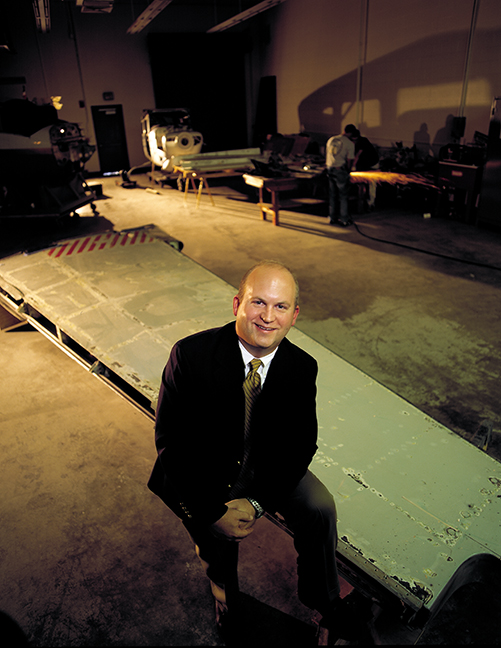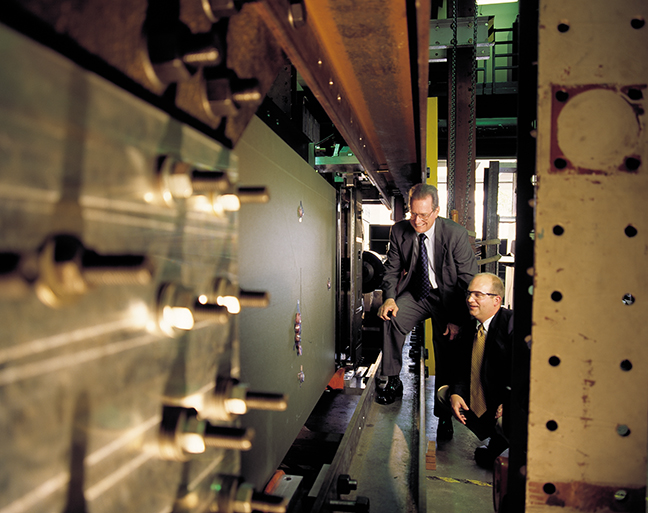
that are a member of two FAA centers of excellence
and none to my knowledge that are a member of three.
We're keeping our fingers crossed."
The 74,000-square-foot, three-story National Institute for Aviation Research dominates the southeast edge of WSU's campus, but few people outside the aircraft industry know what goes on inside.
Changes are in the wind. Tours are being offered so folks can see some of the cutting-edge research happening in that enigmatic building.
It's a welcome breath of fresh air. Change has in fact long been the institute's hallmark.
Boasting a mere three state-of-the-art laboratories at its dedication in 1990, the National Institute for Aviation Research now comprises 18 research labs that are trail-blazers in such front-burner aviation industry interests as ergonomics and occupational biomechanics, aerodynamics, aircraft icing, aging aircraft, mechatronics and systems integration, crash dynamics, human factors, structures, composites and advanced materials, and virtual reality.
"I want to work for Lockheed-Martin because I’m interested in supersonic aircraft, and, since my job in the institute’s Aging Aircraft Lab involves up-close, hands-on shop experience, I’m closer to my goal. Few aerospace students even get to see an airplane before they graduate. I’ve not only seen one but am working on several. They’re not just an abstract to me."
Chris Roberts '04
Aerospace engineering
Not coincidentally, these laboratories provide a wealth of fast-forward work experiences for WSU students that significantly ramp up their career opportunities — and sometimes change their career direction completely. Currently, 46 undergraduates and 34 graduate research assistants, 85 percent of whom are engineering majors, work at NIAR while pursuing their degrees.
"Composites were the last thing on my mind when I entered WSU's aerospace program, but I got a job at the institute's lab and worked there for five years. My first project involved a composite swing arm for the Cannondale mountain bike and the transfer of that technology to the company. I discovered that I really enjoyed composites — and that field became my career."
Kit Bowman '98
Aerospace engineering
materials and process engineer
Scaled Composites
Mojave, Calif.
NIAR's unique ability to quickly adapt to fluid conditions is very like the Kansas breeze that wafts this way and that. "The labs are specifically designed to meet the ever-changing needs of our local and national industry partners, which include Wichita's Big Four," explains John S. Tomblin, interim executive director of the institute. "They use our lab services when and only when they need them."
In-house laboratories are ultra-expensive for any company to boot up and maintain, and they're a necessity only when a company is developing a new product. "Depending on the size of the aircraft or project," says Tomblin, "new products come out anywhere from two to eight years apart. That's a long time to keep a lab optimally equipped and maintained."
And that's where NIAR comes in. The institute has recently added, for example, a new Fatigue and Fracture Laboratory and a Computational Mechanics Laboratory to its roster, and a new laboratory for full-scale and component testing will be sited in WSU's new engineering research facility as soon as construction is finished.
"I worked in the NIAR composites lab for five years. I learned about all the composites processes, and in my spare time I'd use the lab equipment on my own, which the staff encouraged us to do. I built several composite guitars, which was cool, and even better, I became familiar with machines that most people doing composites have heard about but never used."
Matt Stinemetze '98
Aerospace engineering
project engineer, SpaceShipOne
Scaled Composites
It would be just as prohibitively expensive for the institute as for an aircraft company to equip, staff and maintain state-of-the-art laboratories on its own. Therefore, NIAR has developed an invaluable matrix of research and funding partnerships with the aviation industry, government agencies, the Kansas Technology Enterprise Corp. and the State of Kansas.
KTEC has, from the institute’s modest beginnings onward, provided generous funding support. “NIAR has consistently received its core funding from KTEC, and the State of Kansas recently provided funding to the institute to support the state’s aviation industry, which has been especially crucial during the recent economic downturn,” observes Tomblin.
"Five years ago, we were in trouble. The aviation industry was moving out of state and out of the country. Working with federal agencies, legislators, the State of Kansas, KTEC, and NIAR, we brought attention to the problem, and now we have the equipment, facilities and researchers right here in our back yard — at the institute — to conduct cutting-edge research that results in more jobs, reduced costs and improved time-to-market with competitive products. Without WSU and NIAR, that would likely have been impossible."
Robert Waner '70
Vice president of engineering
The Boeing Co.
Wichita
Early on, the institute was named one of KTEC’s five statewide centers of excellence toward its goal of stimulating technology-based economic development in Kansas, and NIAR increasingly became a big player on the national aviation-research scene.
The Federal Aviation Administration recently named the institute as a member of its Airworthiness Assurance Center of Excellence and of its General Aviation Research Center of Excellence. Such designations are more than an honor; they mean nuts-and-bolts, real-dollar, research and development projects that translate to new knowledge, economic growth and jobs in R&D and on the manufacturing floor, plus spin-off applications from which local companies are the first to benefit.
"I was laid off from my job as a Boeing mechanic in 2002, which was the best thing that could have happened, because I returned to WSU to finish my degree. I also work in NIAR’s Aging Aircraft Lab, and it’s just been great. I get to use my sheet-metal experience from Boeing, apply my course work, and learn new things hands-on that relate to both, all of which will be good for my job search after I graduate."
A.J. Kirk '04
Mechanical engineering
NIAR's funding for just one year —$18.2 million in 2002 — demonstrates the solid support the institute receives annually from federal, industry and state sources: The federal government provided 62 percent of that amount; private industry, 14 percent; and the state, 12 percent.
And such funding is expected to increase. As of now, the state’s investment in NIAR is expected to be $20 million over the next four years, and the institute’s designation as two FAA centers of excellence, and potentially a third, virtually guarantees increased federal funding.
Tomblin explains, “Members of a center of excellence are the FAA’s first choice for research. The FAA can’t ask for bids outside the center unless one of us can’t do the project.”
Currently, the institute is working on developing a center of excellence with NASA that would focus upon all-weather operations in future aviation systems —which translates most significantly to icing, a longtime NIAR research specialty — and the institute is on the short list for membership in a third FAA center of excellence: the National Center for Advanced Materials Performance, which will be announced near the end of this year.
“There are very few institutions that are a member of two FAA centers of excellence and none to my knowledge that are a member of three,” comments Tomblin. “We’re keeping our fingers crossed.”

NIAR, and Robert Waner '70, vice president of
engineering at the Boeing Co., check out ongoing
research at one of the institute's 18 research labs.
Tomblin joined the WSU faculty in 1994 as an
assistant professor of aerospace engineering.
But in all probability that won’t be necessary. Right now, NIAR performs fully 70 percent of the FAA’s research on composites.
"Everything I initially learned about composites I learned working in the NIAR composites lab, and my exposure there to various processes and techniques was second to none. At Adam Aircraft, I was project engineer for both the A500 and A700 all-composite aircraft, and if I hadn’t acquired that knowledge and experience at the institute, I wouldn’t be where I am now."
Joe Wilding '96/97
Aerospace engineering
Vice president for advanced development
Adam Aircraft Industries
Englewood, Colo.
The potential leverage for inclusion in a third FAA center of excellence arose from NIAR's milestone involvement in NASA’s Advanced General Aviation Transport Experiments — the AGATE Project — which ran from 1995 through 2001.
AGATE’s goal is to create a small aviation transportation system as an alternative to short-range business and private auto trips. The institute’s role was to refine and make less expensive the process by which composites are certified, a boon to the many small general-aviation companies nationwide that are building composites aircraft.
“That multi-year project firmly established us as a leader in advanced materials research,” Tomblin says. And composites and advanced materials are currently the institute's forte.
"As a research assistant in NIAR’s composites lab, I worked on the AGATE project, and when I was a graduate student, the lab was researching the adhesive bonding of composites for the FAA. Not only was I involved in that, it became the subject of my graduate thesis. Now I’m responsible for getting the structural components of Adam Aircraft’s all-composites A500 and A700 FAA-certified. I’d say my NIAR experience is benefiting both me and the company I work for."
Pierre Harter '98/00
Aerospace engineering
Structures project engineer
Adam Aircraft Industries
And in August 2003, the National Science Foundation released its annual Top Ten list of university-based aerospace program funded-research leaders nationwide for FY 2001 — the most current statistics available — which confirmed that NIAR/WSU had retained the No. 7 ranking on the list, ahead of such aviation-program powerhouses as No. 11’s University of Texas-Austin, No. 15’s Texas A&M and No. 16’s Stanford University. Those ranked higher include Johns Hopkins University, MIT and the Georgia Institute of Technology.
Tomblin comments, “Our ranking clearly demonstrates we can compete with the big guys, and given that our research funding increased by 14.8 percent in FY 2002, we might well move up on the list next year.”
A veritable whirlwind of a director, Tomblin rose through the ranks at WSU beginning in 1994, when he joined the faculty as an assistant professor of aerospace engineering.
He subsequently became a NIAR fellow in composites and structures; an associate professor of aerospace engineering; director of the composites and structures labs; principal investigator for numerous government and industry grants and contracts; principal investigator for NASA's AGATE program, for which he won NASA’s Leadership Award; and interim director of the institute. Along the way, he became NIAR's guru on composites, advanced materials and their testing.
"John’s area of expertise may be composites, but he also excels at understanding and communicating the aviation industry’s needs, and his collaborative approach to meeting those needs is very successful — and very valuable."
Robert Waner
In addition, Tomblin has reached across campus to establish partnerships with, for example, the department of chemistry. “NIAR doesn’t have a monopoly on new knowledge and technology,” Tomblin says with a smile.
Dennis H. Burns, professor and chair of the chemistry department, and William T. Stevenson, polymer chemist and professor of chemistry, were asked to work with NIAR on adhesives and resin research for two Boeing contract projects because airplane components made of composites must be bonded with high-tech glue, not screws and bolts.
"John has a remarkable global vision that includes WSU’s talented faculty members, and his initiative is advancing and underwriting the real-world aspect of our department’s research mission. We’re now doing more contract work for Boeing, and John’s fresh approach to collaboration was instrumental in that."
Dennis Burns
Wichita State chemistry professor
The winds of shifting needs and opportunities continue to reshape the National Institute for Aviation Research, inexorably invigorating the campus, the community, the state and the local and national aviation industry — like a breath of fresh air.





